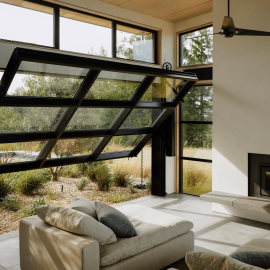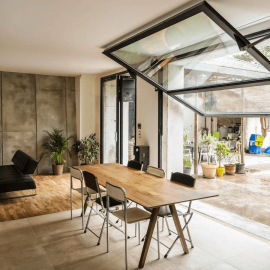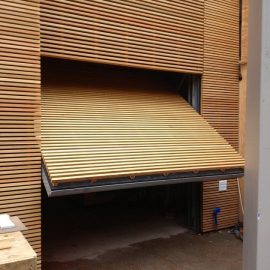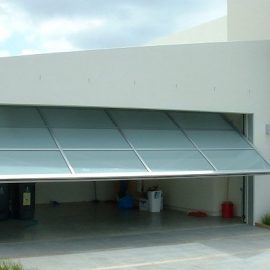IDS Doors - Floataway Doors – Series 1000
Overview
The IDS Floataway Doors – Series 1000 are specially designed and manufactured using precise mathematical calculations to deliver optimal levels of safety, performance and appearance. With a single leaf balanced with counterweights under constant suspension, our Floataway Door – Series 1000 makes an outstanding door solution with the potential of transforming your setting.
Features
- Our Floataway Doors – Series 1000 are customised to harmonize with your design specifications.
- They are counterweight balanced doors designed for industrial / commercial and domestic applications.
- Little headroom is necessary for this type of door.
- The doors accept a prolific range of cladding and glazing materials and come in many colours to suit your design brief.
- When opening, the door moves upward coming to rest in horizontal configuration immediately below the lintel.
- Wind loading can be a critical design factor especially in cyclone prone areas. Unless otherwise specified, these doors are designed to resist a minimum wind loading of 0.5 kPa.
Specifications
Operation:
The Floataway Door is a single leaf door balanced with counterweights under constant suspension. Door movement is controlled by guide bearings running in vertical 60 x 70 x 60 x 3m guide channels and flat mild steel link arms connecting the door to the side guides.
Size:
- Maximum height – 6 metres
- Maximum width – 10 metres
Operations constraints may limit the use of this door. Please consult the manufacturer prior to specifying large openings.
Cladding (Steel):
Doors can be clad with various sheeting materials. If you want to go with a standard Colorbond profile, it’ll be mainly made out of steel, however specialised profiles can be used.
Cladding (Glass):
Doors can be partially or fully glazed for viewing or showroom display and are glazed in accordance with AS1288. Standard glazing uses 6.38mm laminated safety glass. The use of other glass or glazing material should be referred to the manufacturer due to additional weight, deflection, door design & construction. Glazed doors will generally incorporate a kickplate in the base of the bottom leaf. Door size & weight will determine kick plate height.
Finishes:
Standard finish on frames & channels is epoxy primed & polyurethane. On glazed doors beading can be anodised or powder coat finish.
Locking:
By use of internal padbolts unless otherwise specified. Motorised doors will not be fitted with locks.
Counterweight Covers:
The counterweights shall be protected and covered with a removable pressed sheet to meet design requirements.
Applications
The IDS Floatway Doors come in various dimensions to suit the application of the door. Generally, these doors are perfect for:
- Schools
- Cafes
- Shopping Centres
- Pharmacies
- Bar Tops
- Counter tops
- Shopfronts
- Bottleshops
- Commercial Properties






